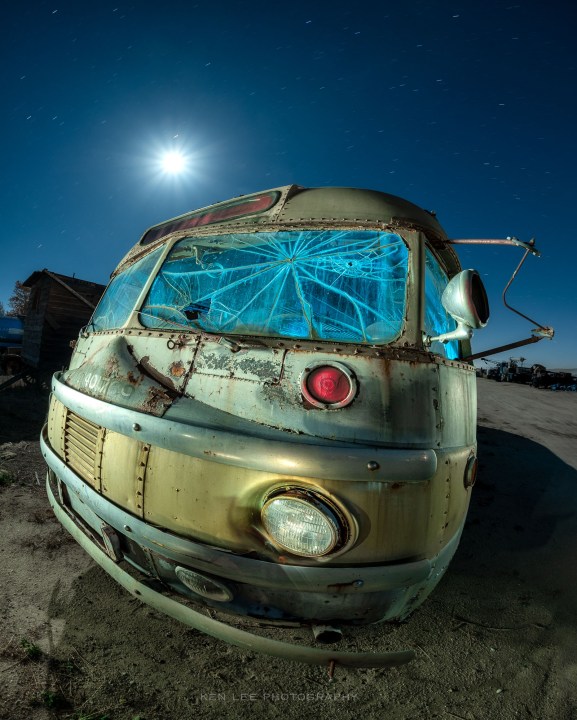Light painting is a term that is often used loosely to describe any addition of light to a night photograph. Really, though, light painting is a technique that uses a handheld light source to illuminate a scene during a long exposure. You are quite literally painting the scene with light. Night photographers have used this technique for many decades.
Here’s how I illuminated an abandoned bus.

Cracks in the glass
I love patina. The cracks in the glass caught my eye, and I wanted to illuminate that to really bring them out.
I used a ProtoMachines LED2 set to a color “patented” by Timothy Little called Gas Station Teal. Using a piece of cardboard to block the light from shining directly into the camera lens, I skimmed along the cracks from the driver’s side window. I walked to the back of the bus and illuminated the rest of the interior through a window because the bus was locked.
Illuminating the front
From there, I walked around to camera left and illuminated the bus. This was in part to mimic the direction of the moon. Sure, the moon is in back of the bus, but it still implies directionality. I used a warm white light for this. I skimmed it off the surface so it would create texture.
Illuminating the headlights
This sometimes confuses people. They cannot figure out why the headlights look like they’re on. Confusion is fun. I used a homemade snoot screwed on to my ProtoMachines light and quickly illuminated this for a second or so using a warm white light. I did the same with the smaller red light on the top, switching the color to red.
The snoot was handy because it forms a tight seal between the light and the tube so it would not “leak” out directly into the lens and leave an odd spot or trail. This was especially important here because the lens was very close to the bus, and I had to get very close to the lens to illuminate the headlights.
The moon
A 78% full moon illuminated the rest of the scene during the 3-minute exposure. This provided just enough light to illuminate the rest of the scene. I kept the scene bright enough that it would have detail, but dark enough that it would provide contrast with the bus.
I hope you found this helpful!
Tell your story with the second annual Visual Storytelling Conference!
Experience four days of interactive, online training sessions featuring a range of educational content with experienced photographers and content creators. This free event kicks off with a series of technical boot camps to build essential skills, followed by live, online sessions on photography, video, business and social media. Join live from March 10-13, 2022!
